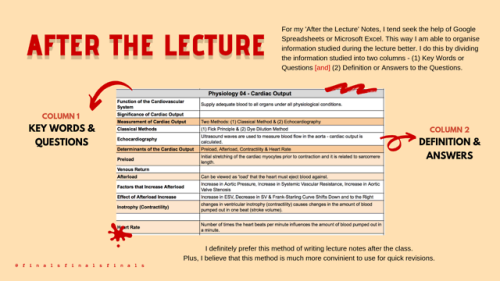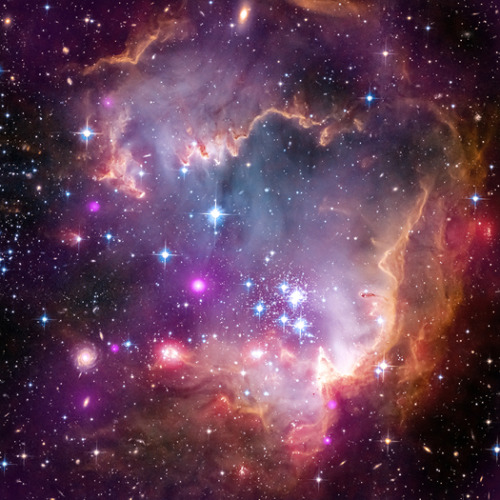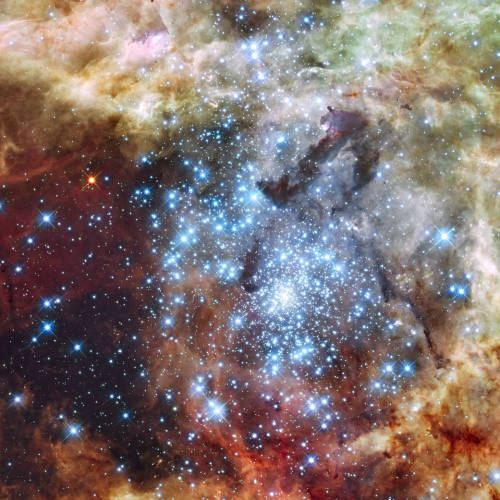I’ve Been Receiving Tonnes Of Questions On Note - Taking Recently, So I’d Thought I Make A Post.





I’ve been receiving tonnes of questions on Note - Taking recently, so I’d thought I make a post. Plus, I had fun making these graphics.
There are three different methods that I prefer when it comes to note taking:
Notes written During the Lecture
I highly recommend taking notes during the lecture.
I also use abbreviations for quicker and more efficient note taking. Some examples of abbreviation that I use are:
w/ - With
w/o - Without
e.g. - For example
Notes written After the Lecture
As for notes written after the lecture, I tend to seek the help of Google Spreadsheets or Microsoft Excel. This way I am able to organise information learnt. I do this by dividing the information provided into two columns, one for keywords or questions and the other for definitions and answers.
*Note: This method was adapted from the note taking method I’ve used during college.
Rewritten Notes
I also rewrite my notes. My rewritten notes are arranged based on the order they appear in the syllabus unless there are pieces of information that are related to more than one topic.
I use a black pen or pencil for my written notes, as well as coloured pens and highlighters to highlight the key words and terminologies for emphasise.
Before writing them down, I tend to visualise the layout - alternating between words and pictures/diagram. This definitely helps me with remembering for exams. All I have to do is imagine that I’m looking at that page and I can remember where everything is.
______________________________________________________________________
Please click on the images for a much clearer view.
Well, that’s all from me! I hope that you found this information helpful. And, don’t hesitate to ask me questions if you’re confused about this method of note-taking, or any other problems you might have. For more information of how to survive university, follow this page. And, for more medical school chronicles, follow me on IG. Follow my studygram/medgram for more content.
More Posts from Study-astronomy-biology-ref and Others










The astro-fashion-loving Internet collectively gasped when ESA’s Hubble twitter account posted three gorgeous gowns, by Czech designer Jirina Tauchmanova with only credit “Photo: Vasek”, which google thinks is a Canadian tennis player. For four long days I couldn’t find anymore images, until, today! Which is why I’m sharing a belated #FashionFriday and #StarrySunday combo.
These gown were shown at Serbia Fashion Week back in December 2015 as Jirina Tauchmanova‘s Spring/Summer 2016 collection – I hope that means they will be available for purchase soon!
I think I recognize at least two of the images, NGC 602 & 30 Doradus, but I’m going to have to see these in person to be sure, yes, definitely, and probably try them on, too.
–Emily

The Carina Nebula - A Birthplace Of Stars
The Carina Nebula lies at an estimated distance of 6,500 to 10,000 light years away from Earth in the constellation Carina. This nebula is one of the most well studied in astrophysics and has a high rate of star formation. The star-burst in the Carina region started around three million years ago when the nebula’s first generation of newborn stars condensed and ignited in the middle of a huge cloud of cold molecular hydrogen. Radiation from these stars carved out an expanding bubble of hot gas. The island-like clumps of dark clouds scattered across the nebula are nodules of dust and gas that are resisting being eaten away by photons (particles of light) that are ionizing the surrounding gas (giving it an electrical charge).
Credit: NASA/Hubble
Largest Batch of Earth-size, Habitable Zone Planets
Our Spitzer Space Telescope has revealed the first known system of seven Earth-size planets around a single star. Three of these planets are firmly located in an area called the habitable zone, where liquid water is most likely to exist on a rocky planet.

This exoplanet system is called TRAPPIST-1, named for The Transiting Planets and Planetesimals Small Telescope (TRAPPIST) in Chile. In May 2016, researchers using TRAPPIST announced they had discovered three planets in the system.

Assisted by several ground-based telescopes, Spitzer confirmed the existence of two of these planets and discovered five additional ones, increasing the number of known planets in the system to seven.

This is the FIRST time three terrestrial planets have been found in the habitable zone of a star, and this is the FIRST time we have been able to measure both the masses and the radius for habitable zone Earth-sized planets.
All of these seven planets could have liquid water, key to life as we know it, under the right atmospheric conditions, but the chances are highest with the three in the habitable zone.

At about 40 light-years (235 trillion miles) from Earth, the system of planets is relatively close to us, in the constellation Aquarius. Because they are located outside of our solar system, these planets are scientifically known as exoplanets. To clarify, exoplanets are planets outside our solar system that orbit a sun-like star.

In this animation, you can see the planets orbiting the star, with the green area representing the famous habitable zone, defined as the range of distance to the star for which an Earth-like planet is the most likely to harbor abundant liquid water on its surface. Planets e, f and g fall in the habitable zone of the star.
Using Spitzer data, the team precisely measured the sizes of the seven planets and developed first estimates of the masses of six of them. The mass of the seventh and farthest exoplanet has not yet been estimated.

For comparison…if our sun was the size of a basketball, the TRAPPIST-1 star would be the size of a golf ball.
Based on their densities, all of the TRAPPIST-1 planets are likely to be rocky. Further observations will not only help determine whether they are rich in water, but also possibly reveal whether any could have liquid water on their surfaces.
The sun at the center of this system is classified as an ultra-cool dwarf and is so cool that liquid water could survive on planets orbiting very close to it, closer than is possible on planets in our solar system. All seven of the TRAPPIST-1 planetary orbits are closer to their host star than Mercury is to our sun.

The planets also are very close to each other. How close? Well, if a person was standing on one of the planet’s surface, they could gaze up and potentially see geological features or clouds of neighboring worlds, which would sometimes appear larger than the moon in Earth’s sky.

The planets may also be tidally-locked to their star, which means the same side of the planet is always facing the star, therefore each side is either perpetual day or night. This could mean they have weather patterns totally unlike those on Earth, such as strong wind blowing from the day side to the night side, and extreme temperature changes.

Because most TRAPPIST-1 planets are likely to be rocky, and they are very close to one another, scientists view the Galilean moons of Jupiter – lo, Europa, Callisto, Ganymede – as good comparisons in our solar system. All of these moons are also tidally locked to Jupiter. The TRAPPIST-1 star is only slightly wider than Jupiter, yet much warmer.
How Did the Spitzer Space Telescope Detect this System?
Spitzer, an infrared telescope that trails Earth as it orbits the sun, was well-suited for studying TRAPPIST-1 because the star glows brightest in infrared light, whose wavelengths are longer than the eye can see. Spitzer is uniquely positioned in its orbit to observe enough crossing (aka transits) of the planets in front of the host star to reveal the complex architecture of the system.

Every time a planet passes by, or transits, a star, it blocks out some light. Spitzer measured the dips in light and based on how big the dip, you can determine the size of the planet. The timing of the transits tells you how long it takes for the planet to orbit the star.

The TRAPPIST-1 system provides one of the best opportunities in the next decade to study the atmospheres around Earth-size planets. Spitzer, Hubble and Kepler will help astronomers plan for follow-up studies using our upcoming James Webb Space Telescope, launching in 2018. With much greater sensitivity, Webb will be able to detect the chemical fingerprints of water, methane, oxygen, ozone and other components of a planet’s atmosphere.
At 40 light-years away, humans won’t be visiting this system in person anytime soon…that said…this poster can help us imagine what it would be like:

Make sure to follow us on Tumblr for your regular dose of space: http://nasa.tumblr.com

If someone is attractive and charming, you’re more likely to assume they’re intelligent and hard working- even if they’re not.
Known as the ‘Halo Effect’, it’s a theory that our generalized judgements of people can bleed over into the more specific judgements we make about them. Studies show that even though we understand the Halo Effect intellectually, it’s almost impossible for us to recognize when it’s actually happening.
(Source, Source 2)

Skull of a woman with monocephalus diprosopus. This is a form of conjoined twinning characterized by a single head and two faces. From the Museum of Anatomy in Montpellier, France.









Cosmic Web
The concept of the cosmic web—viewing the universe as a set of discrete galaxies held together by gravity—is deeply ingrained in cosmology. Yet, little is known about architecture of this network or its characteristics. Our research used data from 24,000 galaxies to construct multiple models of the cosmic web, offering complex blueprints for how galaxies fit together. These three interactive visualizations help us imagine the cosmic web, show us differences between the models, and give us insight into the fundamental structure of the universe.
An awesome work of the Center for Complex Network Research






Could dark energy be caused by frozen neutrinos?
“Since its discovery in 1998, the accelerated expansion has lacked a compelling, simple explanation that didn’t hypothesize a completely new set of forces, properties or interactions. If you wanted a scalar field — a quintessence model — it had to be finely tuned. But in a very clever paper just submitted yesterday by Fergus Simpson, Raul Jimenez, Carlos Pena-Garay, and Licia Verde, they note that if a generic scalar field couples to the neutrinos we have in our Universe, that fine-tuning goes away, and that scalar field will automatically begin behaving as a cosmological constant: as energy inherent to space itself.”
The accelerated expansion of our Universe was one of the biggest surprise discoveries of all-time, and something that still lacks a good physical explanation. While many models of dark energy exist, it remains a completely phenomenological study: everything appears consistent with a cosmological constant, but nothing appears to be a good motivator for why the Universe should have one. Until now, that is! In a new paper by Fergus Simpson, Raul Jimenez, Carlos Pena-Garay and Licia Verde, they note that any generic scalar field that couples to the neutrino sector would dynamically and stably give rise to a type of dark energy that’s indistinguishable from what we’ve observed. The huge advance is that this scenario doesn’t require any fine-tuning, thanks to this dark energy arising from neutrinos “freezing,” or becoming non-relativistic. In addition, there are experimental signatures to look for to confirm it, too, in the form of neutrinoless double-beta decay!
yknow black dwarfs,,, do they actually exist and do they actually live longer than the universe,,
Yes. When stars of a certain mass run out of fuel, they expel their outer layers ( a planetary nebula)
What’s left, in the center is a white dwarf. The core of the original star. Can you see it in the center of this planetary nebula? (NGC 7662)

That white dwarf glows only because of heat, it is not actually making any new light. So, that white dwarf will cool down and leave a dark chunk of mass behind
-
 coloursisee reblogged this · 2 months ago
coloursisee reblogged this · 2 months ago -
 coloursisee liked this · 3 months ago
coloursisee liked this · 3 months ago -
 queerhistorymajor liked this · 8 months ago
queerhistorymajor liked this · 8 months ago -
 edgyghost liked this · 1 year ago
edgyghost liked this · 1 year ago -
 ndirsoccaeverwithd liked this · 1 year ago
ndirsoccaeverwithd liked this · 1 year ago -
 abisecobgor liked this · 1 year ago
abisecobgor liked this · 1 year ago -
 exexnawhymry liked this · 1 year ago
exexnawhymry liked this · 1 year ago -
 languagesandstuff reblogged this · 1 year ago
languagesandstuff reblogged this · 1 year ago -
 fukikosviolin liked this · 1 year ago
fukikosviolin liked this · 1 year ago -
 fallenforfallon liked this · 2 years ago
fallenforfallon liked this · 2 years ago -
 elldrritchteaa liked this · 2 years ago
elldrritchteaa liked this · 2 years ago -
 cutecatsthings liked this · 2 years ago
cutecatsthings liked this · 2 years ago -
 masterpiececonspiracy liked this · 2 years ago
masterpiececonspiracy liked this · 2 years ago -
 apocalypse-soul liked this · 2 years ago
apocalypse-soul liked this · 2 years ago -
 mrragersrevenge96 reblogged this · 2 years ago
mrragersrevenge96 reblogged this · 2 years ago -
 jodeco1982 liked this · 2 years ago
jodeco1982 liked this · 2 years ago -
 sunandglow liked this · 2 years ago
sunandglow liked this · 2 years ago -
 mlw10 liked this · 2 years ago
mlw10 liked this · 2 years ago -
 littlelessmuch reblogged this · 2 years ago
littlelessmuch reblogged this · 2 years ago -
 littlelessmuch liked this · 2 years ago
littlelessmuch liked this · 2 years ago -
 bitchybabe liked this · 2 years ago
bitchybabe liked this · 2 years ago -
 thesquisherroo liked this · 2 years ago
thesquisherroo liked this · 2 years ago -
 studymuse reblogged this · 2 years ago
studymuse reblogged this · 2 years ago

This is a studyblr for everyone have some passion for science, especially astronomy and biology
129 posts

